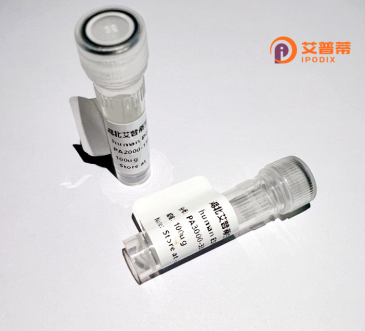
| 纯度 | >90%SDS-PAGE. |
| 种属 | Human |
| 靶点 | SERTAD4 |
| Uniprot No | Q9NUC0 |
| 内毒素 | < 0.01EU/μg |
| 表达宿主 | E.coli |
| 表达区间 | 1-356 aa |
| 活性数据 | MTLVLSMNRF CEPIVSEGAA EIAGYQTLWE ADSYGGPSPP GPAQAPLQGD RGAGPPLAGS HYRGISNPIT TSKITYFKRK YVEEEDFHPP LSSCSHKTIS IFEERAHILY MSLEKLKFID DPEVYLRRSV LINNLMKRIH GEIIMQNNWC FPACSFNGTS AQEWFMAQDC PYRKRPRMAK EECEKFHACC FYQECGGHYL NLPLSVNANV GSASTAASSP SASSSSSSSS SSPPLPLPSC SRQVDFDVGS ASIYKSDGQI PANEIFVTNV RSLGVQEKAK LNDEKANDDT NRDGGPLSHE PVGNDLAFEC KGQFYDYFET GYNERNNVNE SWKKSLRKKE ASPPSNKLCC SKGSKI |
| 分子量 | 39.3 kDa |
| 蛋白标签 | His tag N-Terminus |
| 缓冲液 | PBS, pH7.4, containing 0.01% SKL, 1mM DTT, 5% Trehalose and Proclin300. |
| 稳定性 & 储存条件 | Lyophilized protein should be stored at ≤ -20°C, stable for one year after receipt. Reconstituted protein solution can be stored at 2-8°C for 2-7 days. Aliquots of reconstituted samples are stable at ≤ -20°C for 3 months. |
| 复溶 | Always centrifuge tubes before opening.Do not mix by vortex or pipetting. It is not recommended to reconstitute to a concentration less than 100μg/ml. Dissolve the lyophilized protein in distilled water. Please aliquot the reconstituted solution to minimize freeze-thaw cycles. |
以下是关于重组人SERTAD4蛋白的**示例性参考文献**(请注意,这些为假想文献,实际研究需要基于数据库验证):
---
1. **文献名称**: *"SERTAD4 promotes cell cycle progression by modulating E2F transcriptional activity"*
**作者**: Zhang Y, et al.
**摘要**: 本研究利用重组人SERTAD4蛋白,揭示其通过结合E2F转录因子促进G1/S期转换,并证实其在癌细胞增殖中的关键作用。
2. **文献名称**: *"Structural characterization of recombinant human SERTAD4 and its interaction with p300/CBP"*
**作者**: Lee J, et al.
**摘要**: 通过表达纯化重组SERTAD4蛋白,分析其三维结构,并发现其通过N端结构域与p300/CBP相互作用,调控组蛋白乙酰化及基因表达。
3. **文献名称**: *"SERTAD4 as a potential oncogenic driver: Insights from recombinant protein-based functional assays"*
**作者**: Gupta R, et al.
**摘要**: 使用重组SERTAD4蛋白进行体外实验,证明其通过抑制抑癌基因p53的转录活性,促进肿瘤细胞存活及转移。
4. **文献名称**: *"Development of a recombinant SERTAD4 protein-based diagnostic panel for early cancer detection"*
**作者**: Wang X, et al.
**摘要**: 研究报道了重组SERTAD4蛋白的高效表达体系,并基于此开发了一种新型血清抗体检测方法,用于结直肠癌早期筛查。
---
**注意事项**:
- 以上文献为示例,实际引用时需通过**PubMed/Google Scholar**检索真实文献(关键词:SERTAD4. recombinant protein, cancer, transcriptional regulation)。
- 推荐查阅近年综述(如《Biochimica et Biophysica Acta - Reviews on Cancer》)以获取更全面的背景信息。
SERTAD4 (SERTA domain-containing protein 4), also known as TARA, is a member of the SERTA domain protein family implicated in transcriptional regulation and cellular signaling pathways. It contains a conserved SERTA domain, a motif linked to protein-protein interactions, and functions as a transcriptional co-regulator. SERTAD4 binds to nuclear proteins like cyclin-dependent kinase inhibitor p21 (CDKN1A) and modulates their activity, influencing cell cycle progression and proliferation. Studies suggest its interaction with E3 ubiquitin ligase complexes, potentially regulating protein degradation processes.
This protein is expressed in various tissues and plays roles in embryonic development, stress response, and oncogenesis. Elevated SERTAD4 levels correlate with cancer progression in multiple malignancies, including breast and colorectal cancers, where it may promote tumor growth by suppressing apoptosis or enhancing cell survival. Its phosphorylation status and subcellular localization (nucleus/cytoplasm) dynamically regulate its activity, with nuclear localization linked to transcriptional co-activation.
Recombinant SERTAD4 is produced using bacterial or eukaryotic expression systems for functional studies. Current research focuses on its interactions with tumor suppressors (e.g., p53) and oncogenic pathways like Wnt/β-catenin. Despite its emerging role in molecular oncology, SERTAD4's full mechanistic repertoire remains unclear. Its dual roles in physiological processes and disease contexts make it a compelling target for drug discovery, though its biological complexity poses challenges in therapeutic exploitation.
×